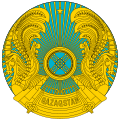|
Regions of Kazakhstan
Kazakhstan is divided into 17 regions (Kazakh: облыстар, romanized: oblystar; sg. облыс, oblys; Russian: области, romanized: oblasti; sg. область, oblast). The regions are further subdivided into districts (Kazakh: аудандар, romanized: audandar; sg. аудан, audan; Russian: районы, romanized: rayony; sg. район, rayon). Three cities, Almaty, Shymkent, and the capital city Astana, do not belong to their surrounding regions. On 16 March 2022, Kazakh President Kassym-Jomart Tokayev announced that three new regions would be created.[1] Abai Region was created from East Kazakhstan Region with its capital in Semey. Ulytau Region was created from Karaganda Region with its capital in Jezkazgan. Jetisu Region was created from Almaty Region with its capital in Taldykorgan; Almaty Region's capital was moved from Taldykorgan to Qonayev.[2] Regions

Demographic statisticsIn 2022, three new regions were created - Abai (from part of East Kazakhstan), Jetisu (from part of Almaty Region) and Ulytau (from part of Karaganda Region). In the following table, the 2009 population totals have been amended to reflect the population in the new or altered regions.
Former administrative boundaries Over the last 60 years, both the distribution and names of regions of Kazakhstan have changed considerably. Major changes were several fusions and splits between Guryev and Mangystau, Karaganda and Dzhezkazgan, Almaty and Taldy-Kurgan, East Kazakhstan and Semipalatinsk and Kostanay, Turgay and Tselinograd, respectively. Changes in region names were often in line with the renaming of cities, such as in the case of Alma-Ata/Almaty. After the administrative reform in 1997, the last change happened since then took place in 1999, when parts of North Kazakhstan that originally belonged to Kokshetau region became part of Akmola. The 1990s merges were in order to dilute the Russian population in the resulting region and to avoid having regions where Russians form a majority.[6]
Notes
References
Sources |
||||||||||||||||||||||||||||||||||||||||||||||||||||||||||||||||||||||||||||||||||||||||||||||||||||||||||||||||||||||||||||||||||||||||||||||||||||||||||||||||||||||||||||||||||||||||||||||||||||||||||||||||||||||||||||||||||||||||||||||||||||||||||||||||||||||||||||||||||||||||||||||||||||||||||||||||||||||||||
Portal di Ensiklopedia Dunia


